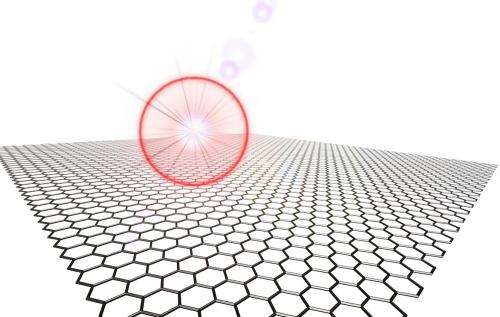June 20, 2011 feature
Lasers could produce much sought-after band gaps in graphene

(PhysOrg.com) -- One of the most often-cited features of graphene – the two-dimensional crystal lattice made of carbon – is its unique electronic properties. Many of these electronic properties make graphene attractive as a material for carbon-based electronics. But also among these properties is that graphene is a gapless semiconductor. As physicist Luis Foa Torres explains, the fact that graphene does not have a band gap is its Achilles’ heel, which makes it difficult to be incorporated into electronic devices.
“In semiconductors, there is an energy region called the band gap where there are no electronic states available,” Foa Torres, at the National University of Córdoba in Córdoba, Argentina, told PhysOrg.com. “One says that the carrier density there is zero. If you have your device connected between two electrodes and it has no states available, then the electric current through it can be made very small. A zero-gap semiconductor, also called a gapless semiconductor, is a material where the density of electronic states vanishes at a single point. This is the case for graphene, where the pi and pi* bands touch at a single point, the so-called Dirac point. In practice, they behave as not having a gap at all.
“Lacking a band gap means that graphene cannot be ‘switched-off,’” he explained. “Having ‘on’ and ‘off’ currents may encode information such as the 1’s and 0’s necessary for computing and is crucial for active electronic devices such as switches and transistors. This is the reason why having no band gap is one of the main drawbacks hindering many applications of this outstanding material.”
In a new study, Foa Torres and his coauthors have addressed this problem. By analyzing the way that a laser field interacts with electrons in graphene, the researchers have predicted that shining a mid-infrared laser on graphene can produce band gaps in its electronic structure. Further, the researchers predict that the band gaps could be tuned by controlling the laser polarization. As Foa Torres explained, the key to how polarized light "opens up" band gaps in graphene involves electrons interacting with the laser field.
“Imagine an electron moving, say from left to right, into a region illuminated by the laser field,” he said. “Then what happens is that the electron interacts with the radiation by absorbing or emitting photons. This interaction leads to the electron being reflected or backscattered, as it would have hit a wall: the band gap. In contrast with usual band gaps, this one is dynamically produced by the laser.”
By showing that a laser field could be used to tune the electronic structure of graphene, the study has both fundamental implications and technological applications.
“The interplay between the peculiar electronic structure of graphene and the laser may help to induce exotic states of matter such as topological insulators, materials that are insulators in the bulk but show robust conduction in the surface,” Foa Torres said. “On the other hand, from an applied point of view, I consider that these laser-induced band gaps could open an avenue for a new breed of optoelectronic devices, devices that transduce optical into electrical signals.”
For Foa Torres and his coauthors, the next crucial step is experimental verification.
“Experimental verification of our findings is one of the main driving forces of our project,” he said. “With the aim of paving the way for experimentalists to be able to verify them, we have performed a very fine tuning of parameters such as laser frequency, amplitude, etc. During the last months we received very valuable feedback from top-level experimental groups in the US and Spain that are interested in our proposal. As always, there are surely still some issues to solve before it turns into reality but one should go step by step. The door is now open, we are just entering a promising terra incognita.”
More information: Hernán L. Calvo, Horacio M. Pastawski, Stephan Roche, Luis E. F. Foa Torres, “Tuning laser-induced band gaps in graphene.” Applied Physics Letters 98, 232103 (2011). DOI: 10.1063/1.3597412
Copyright 2011 PhysOrg.com.
All rights reserved. This material may not be published, broadcast, rewritten or redistributed in whole or part without the express written permission of PhysOrg.com.













.jpg)





